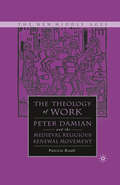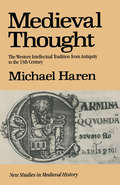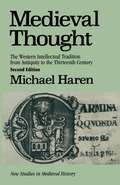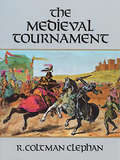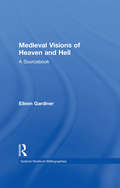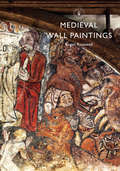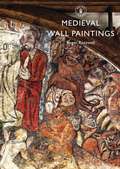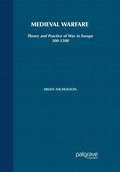- Table View
- List View
Medieval Spain: Culture, Conflict and Coexistence
by R. Collins A. GoodmanThis volume of essays contains contributions from a very wide range of British, American and Spanish scholars. Its primary concern is the relationships between the various ethnic, cultural, regional and religious communities that co-existed in the Iberian peninsula in the later Middle Ages. Conflicts and mutual interactions between them are here explored in a range of both historical and literary studies, to expose something of the rich diversity of the cultural life of later medieval Spain.
Medieval State: Essays Presented to James Campbell
by John MaddicottJames Campbell's work has established the impressive powers of the Anglo-Saxon state, with its ability to impose laws, raise revenue, undertake major works and consult the interests and wishes of its subjects. This collection of essays looks at the state and its successors from a number of angles.
Medieval Statecraft and Perspectives of History: Essays by Joseph Strayer
by Joseph R. Strayer Thomas N. Bisson John F. BentonThis collection of essays by the eminent historian Joseph Strayer makes available in one volume his important shorter studies on the central theme of the political, constitutional, and institutional history of France and England in the twelfth and thirteenth centuries.Originally published in 1971.The Princeton Legacy Library uses the latest print-on-demand technology to again make available previously out-of-print books from the distinguished backlist of Princeton University Press. These editions preserve the original texts of these important books while presenting them in durable paperback and hardcover editions. The goal of the Princeton Legacy Library is to vastly increase access to the rich scholarly heritage found in the thousands of books published by Princeton University Press since its founding in 1905.
A Medieval Storybook
by Morris Bishop Alison Mason Kingsbury"Every medievalist with a sense of humor has wanted to do this sort of book, but too few have. Morris Bishop gives us a delightful collection of medieval storytelling, ranging from the twelfth to the fifteenth century, in Latin, Norse, French, Spanish, Italian, and English. Recommended for all popular collections and especially for children."—Library Journal"A pleasant collection of medieval tales intended for light reading. There are the usual bits and pieces from the Arthurian legend, from the lais and the collections like the ‘Decameron,’ from saints’ lives, and from the moralized exempla of the preachers’ handbooks, all illustrating the lighter side of the extraordinarily rich tradition of medieval narrative art."—Virginia Quarterly ReviewFrom the rich store of medieval tales, Morris Bishop brings together a delightful collection of thirty-five stories. Some are romantic, some religious, some realistic, some even scurrilous. There are merry tales and moral tales, sagas, allegories, and fables. They vary widely in theme and their characters represent every class of medieval society. The tales in A Medieval Storybook vividly illustrate medieval life and thought. Above all they excel as stories, and demonstrate the high level attained by narrative art in the Middle Ages and the great gift the medieval writers had for creating lively and memorable characters. Some of the stories in the book were translated by Bishop; others were translated in the nineteenth and early twentieth centuries. Line drawings by Alison Mason Kingsbury add considerably to the charm of this collection.
Medieval Theology of Work: Peter Damian and the Medieval Religious Renewal Movement (The New Middle Ages)
by P. RanftThis study addresses the need to learn what medieval thinkers had to say about the concept of work by examining the thought of Peter Damian and numerous other religious leaders and groups of the High Middle Ages for evidence of their contributions, deepening our understanding of this concept.
Medieval Thought: The Western Intellectual Tradition from Antiquity to the Thirteenth Century
by M. HarenMedieval Thought: The Western Intellectual Tradition from Antiquity to the Thirteenth Century (New Studies in Medieval History)
by M. HarenThe first edition of this work was received as an authoritative introduction to medieval thought for historians. The book is now issued in a second edition incorporating, besides revisions of detail, an extensive Supplementary Bibliography of recent primary and secondary scholarship and a new concluding chapter which critically surveys and sets in context the implications of the latest research. The text and apparatuses will thus continue to equip readers with a clear overview of the state of the question in a field whose current vigour testifies to its contemporary importance in European intellectual culture.
Medieval Thought and Historiography
by Giles ConstableCollected Studies CS1065We assume that we have a clear understanding of how people in the Middle Ages thought and which attitudes they struck but in reality this is a subject of enormous complexity of which conclusions can only be drawn via painstaking archival research and decades of study. Giles Constable has spent a career analysing these forces and impulses and this new collection draws together his major findings on a host of topics including frontiers, metaphors, religious life and spirituality, and concepts of political theory.
Medieval Thought and Historiography
by Giles ConstableCollected Studies CS1065We assume that we have a clear understanding of how people in the Middle Ages thought and which attitudes they struck but in reality this is a subject of enormous complexity of which conclusions can only be drawn via painstaking archival research and decades of study. Giles Constable has spent a career analysing these forces and impulses and this new collection draws together his major findings on a host of topics including frontiers, metaphors, religious life and spirituality, and concepts of political theory.
The Medieval Tournament
by R. Coltman ClephanComplete, detailed history of English and European tournaments, based on rare manuscripts and original sources. Topics include Arthurian and other round tables, body armor, chain mail, plate armor, royal jousts, introduction of firearms in the 14th century, the tilt, effigies, trial by combat, duels and many other aspects. 24 illustrations. Bibliography. Index.
The Medieval Town in England 1200-1540
by Richard Holt Gervase RosserThis book brings together twelve outstanding articles by eminent historians to throw light on the evolution of medieval towns and the lives of their inhabitants. The essays span the period from the dramatic urban expansion of the thirteenth century to the crises in the fifteenth century as a result of plague, population decline and changes in the economy. Throughout the breadth of current debates surrounding the history of urban society is fully explored.
The Medieval Town in England 1200-1540
by Richard Holt Gervase RosserThis book brings together twelve outstanding articles by eminent historians to throw light on the evolution of medieval towns and the lives of their inhabitants. The essays span the period from the dramatic urban expansion of the thirteenth century to the crises in the fifteenth century as a result of plague, population decline and changes in the economy. Throughout the breadth of current debates surrounding the history of urban society is fully explored.
Medieval Trade in the Eastern Mediterranean and Beyond (Variorum Collected Studies)
by David JacobyCollected Studies CS1066 The articles in this collection cover the region extending from Italy to the Black Sea and to Egypt, over a period of seven centuries, with an emphasis on the considerable economic and social interaction between the West and the regions of the Eastern Mediterranean. They represent key works in the oeuvre of David Jacoby, the doyen of scholars in the field over many decades.
Medieval Trade in the Eastern Mediterranean and Beyond (Variorum Collected Studies)
by David JacobyCollected Studies CS1066 The articles in this collection cover the region extending from Italy to the Black Sea and to Egypt, over a period of seven centuries, with an emphasis on the considerable economic and social interaction between the West and the regions of the Eastern Mediterranean. They represent key works in the oeuvre of David Jacoby, the doyen of scholars in the field over many decades.
The Medieval Village (Cambridge Library Collection - Medieval History Ser.)
by G. G. CoultonRenowned medievalist offers exceptionally detailed, comprehensive and vivid picture of medieval peasant life, including nature of serfdom, manorial customs, village discipline, peasant revolts, the Black Death, justice, tithing, games and dance, much more. Much on exploitation of peasant classes.
Medieval Visions of Heaven and Hell: A Sourcebook (Garland Medieval Bibliographies)
by Eileen GardinerFirst Published in 1993. The present volume covers the currently identified Christian visions of heaven and hell (excluding D ante’s Divine Comedy) from western Europe during the Middle Ages from the late sixth through the fourteenth century.
Medieval Visions of Heaven and Hell: A Sourcebook (Garland Medieval Bibliographies)
by Eileen GardinerFirst Published in 1993. The present volume covers the currently identified Christian visions of heaven and hell (excluding D ante’s Divine Comedy) from western Europe during the Middle Ages from the late sixth through the fourteenth century.
Medieval Wales (British History in Perspective)
by Elena Semenova A.D. CarrThis volume examines the main themes in Welsh history from the coming of the Normans in the eleventh century and their impact on Welsh society and politics to the fall of the Duke of Buckingham, the last great marcher magnate, in 1521. It also looks at the part played by the leaders of the native Welsh community in the years after the conquest of 1282-3. This is one of the less familiar aspects of the medieval history of the British Isles, but one in which there has been an increasing interest in recent yearsWales lost its independence in 1282. Owain Glyn Dwr led a revolt in the early fifteenth century. Henry Tudor was of Welsh descent and landed in Milford Haven in 1485. These are the most familiar facts about the History of Medieval Wales, and today this history is often presented as nothing more than a romantic story of princes and castles. But there is a great deal more to it. Like every other nation, Wales has a history and identity of its own, and Edward I did not bring that history to an end. Unlike England it was not conquered by the Normans. In the thirteenth century the native princess of Gwynedd tried to create a single Welsh principality, and for a short time came close to success. The fourteenth century was much a period of crisis for Wales as for every other part of Europe and the effect of the Black Death lasted a long time. The fifteenth century saw the leaders of the community move on to a wider political stage.Why did conquest come in 1282? Who was Owain Glyn Dwr and why did he rebel? Why was Henry Tudor's bid for power based in Wales and what gave him credibility there? Dr Carr considers these questions and suggests some possible answers as he examines one of the less familiar areas of British History.
Medieval Wall Paintings (Shire Library)
by Roger RosewellThe medieval wall paintings that remain in English churches are for the most part shadows of their former selves – the rare fragments of this beautiful art to have survived not only the Reformation but also successive waves of iconoclastic zeal and unsympathetic restoration. The whitewashed walls of most parish churches belie the riot of colour and decoration that once adorned them, but the remnants of paintings tucked into corners or rescued from later layers of paint help us to understand the role of art in medieval religion. Roger Rosewell here offers a guide to the role played by medieval wall paintings, as religious, didactic and commemorative works of art, telling the stories of those who created them and those who used them on a daily basis. He also compares and contrasts religious and domestic wall paintings, using beautiful colour photography throughout.
Medieval Wall Paintings (Shire Library #767)
by Roger RosewellThe medieval wall paintings that remain in English churches are for the most part shadows of their former selves – the rare fragments of this beautiful art to have survived not only the Reformation but also successive waves of iconoclastic zeal and unsympathetic restoration. The whitewashed walls of most parish churches belie the riot of colour and decoration that once adorned them, but the remnants of paintings tucked into corners or rescued from later layers of paint help us to understand the role of art in medieval religion. Roger Rosewell here offers a guide to the role played by medieval wall paintings, as religious, didactic and commemorative works of art, telling the stories of those who created them and those who used them on a daily basis. He also compares and contrasts religious and domestic wall paintings, using beautiful colour photography throughout.
Medieval Warfare: Theory And Practice Of War In Europe, 300-1500
by Helen NicholsonWarfare in medieval times was never static or predictable - although there were ideals and conventions to follow, in the field commanders had to use their initiative and adapt to the needs of the moment. In this concise, wide-ranging study, Helen Nicholson provides the essential introductory guide to a fascinating subject. Medieval Warfare - surveys and summarises current debates and modern research into warfare throughout the whole of the medieval period across Europe - sets medieval warfare theory and practice firmly into context as a continuation and adaptation of practice under the Roman Empire, tracing its change and development across more than a millennium - considers military personnel, buildings and equipment, as well as the practice of warfare by land and sea
Medieval Warfare: Theory and Practice of War in Europe, 300-1500
by Helen J. NicholsonWarfare in medieval times was never static or predictable - although there were ideals and conventions to follow, in the field commanders had to use their initiative and adapt to the needs of the moment. In this concise, wide-ranging study, Helen Nicholson provides the essential introductory guide to a fascinating subject.Medieval Warfare- surveys and summarises current debates and modern research into warfare throughout the whole of the medieval period across Europe- sets medieval warfare theory and practice firmly into context as a continuation and adaptation of practice under the Roman Empire, tracing its change and development across more than a millennium- considers military personnel, buildings and equipment, as well as the practice of warfare by land and sea
Medieval Warfare: Theory and Practice of War in Europe, 300-1500
by Helen J. NicholsonWarfare in medieval times was never static or predictable - although there were ideals and conventions to follow, in the field commanders had to use their initiative and adapt to the needs of the moment. In this concise, wide-ranging study, Helen Nicholson provides the essential introductory guide to a fascinating subject.Medieval Warfare- Surveys and summarises current debates and modern research into warfare throughout the whole of the medieval period across Europe- Sets medieval warfare theory and practice firmly into context as a continuation and adaptation of practice under the Roman Empire, tracing its change and development across more than a millennium- Considers military personnel, buildings and equipment, as well as the practice of warfare by land and sea
Medieval Warfare 1000–1300 (The International Library of Essays on Military History)
by John FranceThe study of medieval warfare has developed enormously in recent years. The figure of the armoured mounted knight, who was believed to have materialized in Carolingian times, long dominated all discussion of the subject. It is now understood that the knight emerged over a long period of time and that he was never alone on the field of conflict. Infantry, at all times, played a substantial role in conflict, and the notion that they were in some way invented only in the fourteenth century is no longer sustainable. Moreover, modern writers have examined campaigns which for long seemed pointless because they did not lead to spectacular events like battles. As a result, we now understand the pattern of medieval war which often did not depend on battle but on exerting pressure on the opponent by economic warfare. This pattern was intensified by the existence of castles, and careful study has revealed much about their development and the evolving means of attacking them. Crusading warfare pitted westerners against a novel style of war and affords an opportunity to assess the military effectiveness of European methods. New areas of study are now developing. The logistics of medieval armies was always badly neglected, while until very recently there was a silence on the victims of war. Assembled in this volume are 31 papers which represent milestones in the development of the new ideas about medieval warfare, set in context by an introductory essay.
Medieval Warfare 1000–1300 (The International Library of Essays on Military History)
by John FranceThe study of medieval warfare has developed enormously in recent years. The figure of the armoured mounted knight, who was believed to have materialized in Carolingian times, long dominated all discussion of the subject. It is now understood that the knight emerged over a long period of time and that he was never alone on the field of conflict. Infantry, at all times, played a substantial role in conflict, and the notion that they were in some way invented only in the fourteenth century is no longer sustainable. Moreover, modern writers have examined campaigns which for long seemed pointless because they did not lead to spectacular events like battles. As a result, we now understand the pattern of medieval war which often did not depend on battle but on exerting pressure on the opponent by economic warfare. This pattern was intensified by the existence of castles, and careful study has revealed much about their development and the evolving means of attacking them. Crusading warfare pitted westerners against a novel style of war and affords an opportunity to assess the military effectiveness of European methods. New areas of study are now developing. The logistics of medieval armies was always badly neglected, while until very recently there was a silence on the victims of war. Assembled in this volume are 31 papers which represent milestones in the development of the new ideas about medieval warfare, set in context by an introductory essay.




